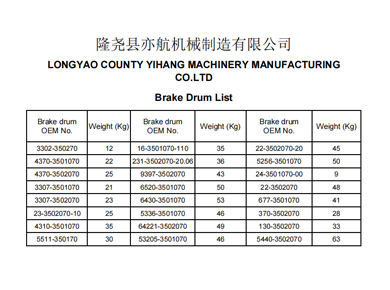Lis . 27, 2024 04:43 Back to list
Steps for Accurately Measuring Brake Drum Size and Specifications
How to Measure Brake Drum A Comprehensive Guide
Brake drums are vital components of a vehicle's braking system, ensuring that the vehicle comes to a safe stop. Over time, brake drums can wear down, leading to decreased effectiveness and safety. Therefore, measuring the brake drum is crucial for vehicle maintenance. In this guide, we will walk you through how to properly measure a brake drum to assess its condition and whether it needs replacement.
Tools Needed
Before starting, gather the following tools
1. Digital Caliper or Micrometer These tools will help you precisely measure the diameter of the brake drum. 2. Ruler or Measuring Tape For general measurements, a standard ruler or measuring tape can be useful. 3. Brake Drum Gauge This specialized tool will assist in measuring the inside diameter and checking for any wear patterns. 4. Safety Equipment Always wear safety glasses and gloves to protect yourself when working on your vehicle.
Step-by-Step Process
1. Remove the Wheel Start by safely lifting the vehicle using a jack and securing it with jack stands. Then, remove the wheel to access the brake drum.
2. Inspect the Brake Drum Before taking measurements, visually inspect the brake drum for any signs of significant wear, cracks, or warping. These indicators can suggest that the drum may need replacing before measuring.
how to measure brake drum

3. Measure the Outside Diameter Using a digital caliper or micrometer, measure the outside diameter of the brake drum. This measurement is vital for determining the drum's condition. Ensure that you take measurements at several points (e.g., at the front, back, and sides) to get an accurate reading, as wear may not be uniform.
4. Measure the Inside Diameter Next, measure the inside diameter of the drum. This is where the brake shoes make contact with the drum. Use a brake drum gauge to get the most accurate inside measurement. This gauge can also indicate if the drum has been worn unevenly.
5. Check for Taper and Scoring While measuring the inside diameter, be on the lookout for taper (where the diameter changes from top to bottom) and scoring (grooves or marks on the drum's surface). Tapered or scored drums can affect braking performance and may require turning or replacement.
6. Compare with Specifications Once you have your measurements, compare them to the factory specifications for that specific brake drum model. Most vehicle manufacturers provide minimum thickness specifications. If your measurements indicate that the drum is below this minimum, it's time to replace it.
7. Reassemble the Brake Components After taking all necessary measurements and notes, carefully reassemble the brake components and wheel. Ensure everything is tightened to manufacturer specifications.
Conclusion
Measuring a brake drum is a straightforward process that can significantly impact your vehicle's safety and performance. Regular inspection and measurement can help identify issues early and prevent more severe brake problems down the line. Always refer to your vehicle's service manual for specific details and follow safety precautions when working on your vehicle. If you are uncertain at any point, consult a professional mechanic to ensure your braking system remains in optimal working condition. By taking the time to measure your brake drum, you're investing in the safety of yourself and others on the road.
-
High-Quality Trailers for Towing Needs | Shop Now
NewsJul.25,2025
-
Premium MAN Shaving Kit for Effortless Comfort
NewsJul.25,2025
-
HINO Advanced Machinery Solutions - LONGYAO COUNTY YIHANG MACHINERY | Industrial Efficiency&Customization
NewsJul.21,2025
-
HINO Machinery Solutions - LONGYAO COUNTY YIHANG MACHINERY MANUFACTURING CO.LTD | Precision Engineering, Customizable Configurations
NewsJul.21,2025
-
HINO Machinery Solutions - LONGYAO COUNTY YIHANG MACHINERY MANUFACTURING CO.LTD | Precision Engineering, Customizable Configurations
NewsJul.21,2025
-
HINO Machinery Solutions - LONGYAO COUNTY YIHANG MACHINERY MANUFACTURING CO.LTD | Precision Engineering, Customizable Configurations
NewsJul.21,2025
